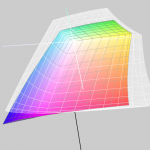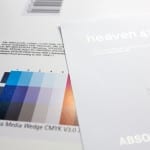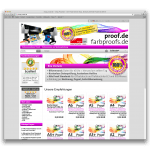Proofing service providers are often asked the question: “I have to have a proof done, but I don’t know for which profile. Can I also have a proof made without a profile?”
Proofs are standardized products that are created and tested according to a certain set of values. This is exactly the point that distinguishes them from any “colourful printouts”.
Specifically: A proof for coated printing paper is produced according to the standard values of ISOCoated V2 (paper type 1 and 2, glossy and matt coated image printing, dot gain curves A (CMY) and B (K) from ISO 12647-2:2004) and checked according to a set of values (FOGRA39L). A proof for uncoated paper (e.g. PSOUncoated or ISOUncoated) is produced and checked according to completely different value sets. Logically, because a print on uncoated paper looks definitely different in terms of colour and white value than a print on picture printing paper.
A proof must therefore always be prepared according to a standard and be verifiable according to a reference value set. A list of the current Proof Profiles (as of 2012) can be found here.
The problem: Many printing processes such as digital printing on a color laser or printing on a large format printing system (LFP) are not standardized and therefore there are no valid profiles and specifications.
So what to do? The most frequently used standard has established itself as the “de facto basis”: ISOCoated V2.
This is understandable, because colour-critical prints, catalogues etc. are mainly produced in offset printing on picture printing paper and are therefore subject to this standard. It is therefore generally assumed that a digital printer or an LFP printer, for example, should follow this standard and at least achieve this colour result.
So if you need to make a proof but don’t have the exact details of the profile you need, proof ISOCoated V2, which has become the industry’s most widely used standard and will always be accepted as the basic proof.
Unfortunately, a proof without a profile cannot be produced, because that would just be “colored paper from a proofing system”, but not a valid, ISO-compliant proof.

A few days ago we received a call from a customer in the field of design, who sent open Adobe InDesign data in ISOCoatedV2 300% with contained RGB images to the production company for a complex CD production on the advice of the producing company (“The printing company still has a prepress stage, which can then prepare your data optimally…”). The result of the finished printed CD booklets and inlays did not correspond at all to the calibrated monitor image of our customer, the client was also unhappy and requested … read more

The Proof GmbH provides proofs for Scheufelen Heaven 42 papers on the new EFI 8245 OBA proofing paper. With this new proofing paper it is now possible to proof the bright-white paper dye of Heaven42l. With Heaven 42 a bright white paper was developed by the German paper company Scheufelen, which opened up a new color whiteness. Especially technical motifs (shades of gray, silver tones from 4c, strong contrasts) act on Heaven 42 particularly brilliant and neutral. With an unchanged separation (eg with ICC profile “ISOcoated_v2”), but the printed image with the … read more

In this short image video we – the Proof GmbH – introduce us and our work. Find out who we are and what drives us. What do you think of our short film?

Offset and Newsprint ISO Coated v2 (ECI) / ISO Coated v2 300% (ECI) Profile: ISOcoated_v2_eci.icc Standard for glossy and matte coated paper Paper: Types 1 and 2, gloss and matte coated Tone value increase curves A (CMY) and B (K) as defined in ISO 12647-2:2004 Characterisation Data: FOGRA39L ISOUncoated Profile: ISOUncoated.icc Standard for uncoated white natural paper Paper: paper grade 4, uncoated white offset, dot gain curves C (CMY) and D (K) from ISO 12647-2: 2004 Characterisation Data: FOGRA29L PSOCoatedV3 / Fogra 51 Profile: PSOcoated_v3.icc The successor of ISOCoatedV2 for glossy … read more

EAN codes are standard on every product today. While in the good old days, shopowners themselves typed the prices into a cash register by hand, today scanner cash registers are the rule, which scan standardized EAN codes with a laser and thus clearly recognize the article and add it to the receipt. EAN, by the way, stands for “European Article Number” and was replaced in 2009 by the global GTIN, “Global Trade Item Number”. The EAN or GTIN is a barcode that can be read automatically and read by barcode … read more

From now on you can conveniently order proofs at shop.proof.de: At shop.proof.de is available under shop.proof.de a comfortable online shop with numerous benefits available: Convenient Data Upload: Each item one or more files can now be uploaded. So you can assign your data directly to the individual proofs. Payment by Paypal, direct debit, invoice etc .: You are on shop.proof.de with Paypal and direct debit payment methods more available. Of course you can continue to conveniently order proofs on invoice. See Previous orders, invoices, data uploads: You can always check your … read more

Digimarc is a digital watermark that can be used to embed information in images, videos or other media. Digimarc watermarks are invisible to the human eye, but remain recognisable to special software or devices. Digimarc is becoming increasingly popular in the packaging sector in particular, as this technology allows the digits of the EAN barcode and more to be applied invisibly to all areas of the packaging. Digimarc and EAN barcode at the supermarket checkout When scanning at the checkout, the checkout staff do not have to search for the … read more

Requests such as the proof of a printed tin can often reach us. Why can’t such a printed can be “proofed”? A proof is a standardized product. Take the classic ISOCoatedV2 proof, for example; the standard proof for coated printing paper. Here is the definition in brief: “Paper type 1 and 2, glossy and matt coated paper, dot gain curves A (CMY) and B (K) from ISO 12647-2:2004” (Source: farbproofs.de) Metal is printed with a varnish. Neither the colour of the metal of the tin can nor the colour of … read more

Customers are often unsettled when they hold a proof in their hands. “The proof of the picture is much darker than the picture on my monitor. Why is that so? And what do I do now?” There are many possible reasons for a deviation between the proof and, for example, the monitor display: The monitor is not calibrated Only calibrated monitors can accurately display color. When I buy a cheap monitor and connect it to my computer, I definitely can’t see any real color. As a rule of thumb, only … read more

“We print 135gr/sqm on a Berberich Allegro. Can you make us a proof on this paper? Can you proof on our final production paper?” Our telephone support often asks for a proof on production paper. Unfortunately, we always have to answer the question negatively. I would like to briefly explain the reasons for this in the following article. Proofing on production paper is still technically impossible. All proofing systems currently certified by Fogra are based on an inkjet printer as a test printer, mostly from Epson, Canon or HP. These … read more






